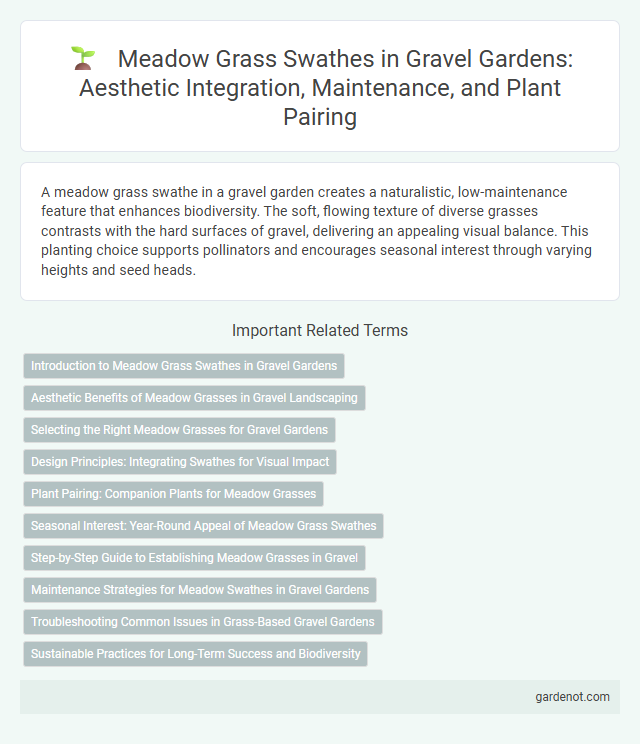A meadow grass swathe in a gravel garden creates a naturalistic, low-maintenance feature that enhances biodiversity. The soft, flowing texture of diverse grasses contrasts with the hard surfaces of gravel, delivering an appealing visual balance. This planting choice supports pollinators and encourages seasonal interest through varying heights and seed heads.
Introduction to Meadow Grass Swathes in Gravel Gardens
Meadow grass swathes in gravel gardens create dynamic, naturalistic textures that enhance biodiversity and visual interest. These grass clusters thrive in well-drained, nutrient-poor soils typical of gravel gardens, offering resilience and seasonal movement. Incorporating native meadow grasses like Festuca rubra or Deschampsia cespitosa promotes sustainable, low-maintenance landscapes with ecological benefits.
Aesthetic Benefits of Meadow Grasses in Gravel Landscaping
Meadow grasses in gravel garden design create a soft, natural contrast that enhances visual interest with their varying textures and seasonal colors. Their graceful movement in the breeze adds a dynamic, calming element that elevates the overall aesthetic appeal. Integrating meadow grass swathes also promotes biodiversity, supporting pollinators while maintaining a low-maintenance, eco-friendly landscape.
Selecting the Right Meadow Grasses for Gravel Gardens
Selecting the right meadow grasses for gravel gardens involves choosing drought-tolerant species such as Festuca ovina, Stipa tenuissima, and Bouteloua gracilis, which thrive in well-drained, nutrient-poor soils. These grasses provide texture and movement, enhancing the visual appeal while requiring minimal maintenance. Incorporating native varieties adapted to local climate conditions promotes ecological balance and supports pollinators in gravel garden ecosystems.
Design Principles: Integrating Swathes for Visual Impact
Meadow grass swathes in gravel gardens create striking visual contrast by introducing natural textures and movement alongside hardscape elements. Strategic placement of swathes follows design principles such as rhythm, scale, and balance to guide the eye and enhance spatial depth. Selecting species with varying heights and seasonal colors amplifies the dynamic interplay between gravel surfaces and living plant forms.
Plant Pairing: Companion Plants for Meadow Grasses
Meadow grasses thrive when paired with companion plants such as wildflowers like black-eyed Susan, coneflowers, and native legumes, which enhance biodiversity and provide habitat for pollinators. Deep-rooted plants like goldenrod and yarrow stabilize soil and improve nutrient cycling, supporting the health of meadow grass swathes. This plant pairing creates a resilient, low-maintenance gravel garden with sustained ecological balance and visual appeal.
Seasonal Interest: Year-Round Appeal of Meadow Grass Swathes
Meadow grass swathes provide exceptional seasonal interest, showcasing dynamic color palettes from fresh greens in spring to golden amber hues in autumn. This naturalistic planting supports biodiversity by attracting pollinators and birds throughout the year. Its low-maintenance growth habit makes it ideal for gravel gardens seeking sustainable and visually appealing ground cover across all seasons.
Step-by-Step Guide to Establishing Meadow Grasses in Gravel
Prepare the gravel garden by loosening the soil beneath to enhance drainage and root penetration for meadow grasses. Select a mix of native meadow grass species adapted to the local climate and sow seeds evenly across the prepared area, lightly raking them into the surface. Maintain consistent moisture without waterlogging and monitor growth to thin out weaker shoots, ensuring a dense, thriving meadow grass swathe in your gravel garden.
Maintenance Strategies for Meadow Swathes in Gravel Gardens
Meadow grass swathes in gravel gardens require targeted maintenance strategies to promote healthy growth and aesthetic appeal. Regular mowing at a high setting encourages dense root development, while periodic removal of thatch prevents soil compaction and nutrient depletion. Implementing seasonal watering schedules and selective weeding ensures the meadow grasses thrive without overpowering the gravel garden's design elements.
Troubleshooting Common Issues in Grass-Based Gravel Gardens
Meadow grass in gravel gardens often faces challenges such as poor drainage and nutrient deficiency, leading to yellowing and stunted growth. Regular soil testing combined with improved irrigation and organic mulching helps maintain optimal moisture and nutrient levels. Addressing compaction by aeration promotes healthy root development and prevents patchy, thin grass swathes in your gravel garden.
Sustainable Practices for Long-Term Success and Biodiversity
Meadow grass swathes in gravel gardens enhance sustainability by improving soil structure and supporting diverse native pollinators, which promotes long-term ecological balance. Implementing rotational mowing and avoiding chemical inputs preserves habitat integrity and encourages natural regeneration. Integrating diverse grass species fosters resilience against pests and climate fluctuations, securing biodiversity and garden vitality over time.
Meadow grass swathe Infographic

 gardenot.com
gardenot.com